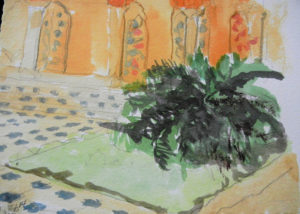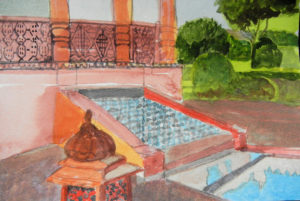Even when I don’t complete a painting to my satisfaction, I feel I have owned the garden for my own earthly delights. The garden and I become one entity. I am happy. I experience such joy in Gardens of Paradise.
A glimpse into Gardens of Paradise – where I feel so at peace – is a quest I fulfilled during a two-week visit to the Mughal gardens of India. In the spring of 2012, I happily roamed these 16th- century gardens as part of a tour led by Patrick Bowes, a landscape architect and historian from Ireland.
“The true Mughal gardens have four canals of water running from the center of the garden,” so says Patrick, as he and I stroll into the Taj Mahal, a garden designed by Shah Jahan as a mausoleum for his favorite wife. “The four canals usually meet in the center of the garden at a temple or fountain, at a holy spot which represents the God of Mohammed. Water is the holy essence and man must walk beside – outside — the holy centrality. The canals further divide the garden into four sections where flowers and trees are planted. This garden pattern originated in Persia and is called Gardens of Paradise, due to the derivation of the word for a wall enclosing a garden on all four sides. The word is Pairadaeza.” He adds, “Xenophon, a Greek writer, was the first to identify such a garden design as ‘paradise’ and in Hellenistic times, the Greek word also appears in the Bible, where Pairadaeza is named ‘Garden of Eden.’”

Among the best examples of Mughal gardens, in addition to the Taj Mahal in Agra, are Agra Fort; the 18th-century garden laid out by a Maharajah of Bharatpur in Deeg; the City Palace of the Maharajas and Amber Fort in Jaipur; Samode Bagh, a 250-year-old garden with 42 fountains in the Jaipur countryside; Emperor Humayun’s tomb, with gardens restored by the Aga Khan Foundation for Islamic Architecture, in New Delhi; and Red Fort with audience halls of Shah Jahan in Old Delhi. I could describe each one as unique, even as they all fulfill the Mughal garden design.
I find the most accessible places to paint are gardens at hotels which have been Indian palaces. In Agra, where the Taj Mahal looms off in the distant mist, I find a corner within an hour of arrival at the lovely Oberoi Amarvilas hotel with a modern garden full of terraces, fountains, reflecting pools, and pavilions. I have only an hour before the sun sinks into night. I am tired from the long bus ride from New Delhi where I arrived just the night before.
With my viewfinder, I decide on a simple composition of a prehistoric fern which dates from the days of the dinosaurs. It has lovely forest green fronds spiking in a dome shape. Behind the fern, I can see black and white marble tiled steps leading up to a covered walkway. The walkway is supported by Moorish fluted arches held by shapely columns. And inside the walkway, I can see wall frescoes of flowers growing on tall single stalks – a design I later see at the Taj Mahal. The flower petals are too shapely to be natural and resemble more the graceful turn of leaves blowing in a soft breeze.

I set up my easel and place a pad of cold-press watercolor paper in my line of sight and draw in the vignette with a pencil. The sun is going down and I am losing shadows and light streaks across the stairs. I continue to put in color, but so quickly that I nearly lose control of my brush strokes. The color in the frescos is intense and I am fearful that I have ruined my first painting in India. I wish I had more time to paint in this Oberoi hotel. It is truly a marble palace.
The next garden of delight is Jai Mahal Palace hotel. My room looks out onto the garden and each night I am there, big Indian weddings are staged. Garden pavilions are hung with pink draperies. Twinkling lights glitter in trees. But I ignore the glitter late one afternoon when I choose a sight to paint: one of the falling-water channels beside a pavilion. It is growing dark, again, and I work fast. I draw with pencil and whip out orange and green watercolors to establish basic color fields. Then the night lights come on and the night turns black. I must finish this painting later.
